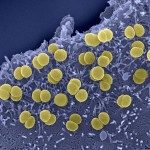Link to Pubmed [PMID] – 26226598
Link to DOI – 10.1016/j.jinf.2015.07.007S0163-4453(15)00232-7
J Infect 2015 Nov; 71(5): 544-52
Neisseria meningitidis is a leading cause of meningitis and septicaemia. The hyperinvasive ST-11 clonal complex (cc11) caused serogroup C (MenC) outbreaks in the US military in the 1960s and UK universities in the 1990s, a global Hajj-associated serogroup W (MenW) outbreak in 2000-2001, and subsequent MenW epidemics in sub-Saharan Africa. More recently, endemic MenW disease has expanded in South Africa, South America and the UK, and MenC cases have been reported among European and North American men who have sex with men (MSM). Routine typing schemes poorly resolve cc11 so we established the population structure at genomic resolution.Representatives of these episodes and other geo-temporally diverse cc11 meningococci (n = 750) were compared across 1546 core genes and visualised on phylogenetic networks.MenW isolates were confined to a distal portion of one of two main lineages with MenB and MenC isolates interspersed elsewhere. An expanding South American/UK MenW strain was distinct from the ‘Hajj outbreak’ strain and a closely related endemic South African strain. Recent MenC isolates from MSM in France and the UK were closely related but distinct.High resolution ‘genomic’ multilocus sequence typing is necessary to resolve and monitor the spread of diverse cc11 lineages globally.

